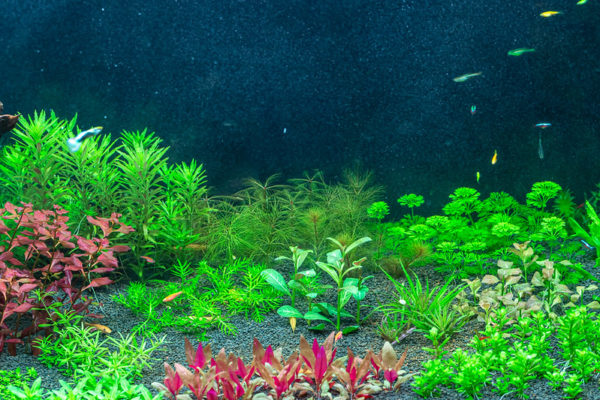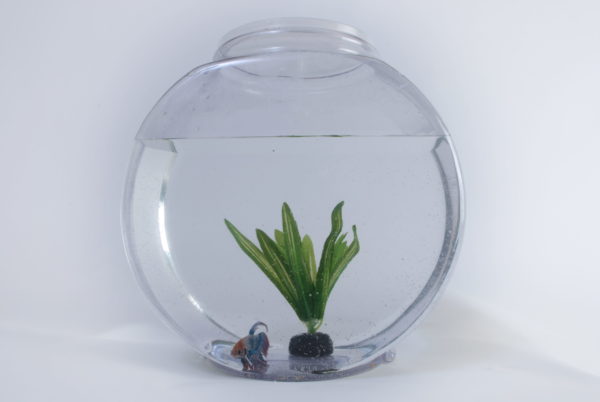Aquatic plants are one of the surefire methods to improve the aesthetic of your aquarium. They clean up the tank’s look and add a bit of color and pop to it. Live plants in your aquarium look so much better than faux plants. They also come with many more benefits, like inhibiting algae growth. They also reduce the ammonia content present in your tank by consuming it. Another advantage of placing live plants in your aquarium is creating an environment that gives off a far more natural.
A lot of people tend to add potted plants into their aquariums. This can be pretty daunting in case it has not been done before. Don’t worry too much, though. This article should help you gain the required confidence to go ahead and plant your first potted aquatic plants in the aquarium.
Table of Contents
Why add potted plants to your aquarium?

We briefly touched upon some of the benefits that live plants bring to your aquarium. These benefits included the aesthetic they give off, the inhibition of algae growth, and the reduction of ammonia content. The environment created by the addition of these plants also seemed far more natural. They also help reduce phosphates and nitrates while increasing the oxygen content and absorbing carbon dioxide. This helps facilitate the healthier growth of all the life in the tank, including the fish that inhabit it.
Unlike plants planted in the aquarium substrate, potted plants are not fixed to one single place in the tank. Since they do not have roots that grow deep into the substrate and hold onto it, they are free to be moved around. As a result, they are a very flexible addition to any aquarium. The only thing left for you to do is to pick out plants compatible with the fish in the tank.
What kind of pot is safe for aquarium use?
One of the first things that would strike you when adding a potted plant to your aquarium is what kind of container or pot to use for the plant. The main motivation behind this is to find out what type of container is not hazardous for your plant or its life.
A few people use ceramic pots for their potted aquarium plants. These tend to be safe, but not all kinds. For example, ceramic labeled dinnerware safe is usually alright to pot plants in the aquarium. If you can eat off of it, you can plant in it and place it in your tank.
Terracotta is another iteration of ceramic. This is also considered to be a material that people can use for their aquatic plants. These are also safe for aquarium use as long as they have not been glazed or been painted in matte. Another thing you will need to ensure is that the pots are free of broken or jagged edges. These could potentially injure the other aquatic life in the tank while also hazardous to the person who takes care of the aquarium.
Clay pots are another commonly used alternative to pot plants in aquaria. Here, you must be very careful as many different varieties of clay pots are available. Not all of them are safe for use. They may contain toxic chemicals that may be released when submerged in water. Simply put, steer clear of any clay that can be molded when wet, but dries when exposed to air. Another type of clay to avoid would be the polymer clay hardened by baking. This, too, could lead to chemicals slowly dissolving into the water once it is submerged.
How to plant aquarium plants in pots?

We said earlier that putting your plants in pots rather than the substrate of the tank has many advantages. So now, let us go ahead and see how we can plant aquarium plants in pots.
We start by first soaking our soil in water. Let it soak until the consistency is similar to a mud pie. Now, go ahead and fill up your pot with the soil and avoid the formation of too many air bubbles. If you end up with some, tap down on the soil to get rid of them.
Now, use your fingers to make a well of sorts in the center of the soil in the pot. Let the depth go down nearly to the bottom. Next, set the plant here, but ensure that the roots are hanging straight down under the plant. While carefully holding the plant from above, fill the area around the roots with wet soil.
Cover up the top layer of the soil with gravel and give it a gentle pat. The weight of the gravel will prevent too much of the soil from being misplaced when the plant is submerged. Now, take your potted plant and drop it into a large container enough to submerge the plant and pot both. Gently and slowly lower the pot into this container. This will release any remaining air bubbles that you may not have been able to get rid of while adding the soil.
Now, you can place your plant anywhere you desire inside the aquarium after pulling it out of the container. Keep in mind that when you lower it into the water, you need to be gentle.
Some of the Best Potted Aquarium Plants
There are a lot of plants that can be potted and placed in an aquarium. Some of the best and most popular among these plants are listed in this section here. A general trend you will see when it comes to potted aquatic plants is that they are usually a bit older and grown out compared to the ones directly planted in the substrate.
Let us now take a look at some of the most popular potted plants placed in aquariums. The following two plants are trendy among both beginners and veteran aquarists. The Bacopa Monnieiri and the Vallisneria Torta. Both of these plants are very popular due to their hardy nature. They manage to live and survive without too many requirements. They also can withstand a wide range of changes in water conditions.
Some other potted plants that you could go ahead and try out are listed.
- A lot of anubias like the Anubias Barteri or Anubias Nana Petite is a good choice.
- The Brazilian Pennywort (Hydrocotyle)
- Pearl Weed Baby Tears
- The Super Red Mini Ludwigia
- The Monte Carlo (Micranthemum Tweediei)
How to take care of aquarium potted plants
When you buy potted aquarium plants, the first thing that you have to do is remove the plant from the pot. The primary purpose is to pull the rock wool that the roots are grown into. After this, you can go ahead and re-pot the plant. Unfortunately, the rock wool is a bit of a hazard to your fish as it can get jammed into the fish’s gills and hurt them.
Another thing to do is keep your plants grounded and make sure they do not float around the tank. You can do this in many ways. Some of the best ways of doing this are by adding a small layer of gravel on top of the soil. Next, drain all the excess air bubbles from the soil. This will prevent the displacement of the soil by air bubbles rising from the bottom. You could also try and tie the plant to a solid and weighted object. However, this isn’t the best option as it could potentially injure your fish.
The most important thing is to ensure that the water conditions required by your plant are met. Most plants are comfortable with a pH value between 6.5 and 7.8. They also generally thrive when the water hardness is between 50 and 100 particles per million with alkalinity that ranges from 3 to 8 KH. Try to keep the nitrates under ten particles per million and phosphates below 0.5 ppm. This is mainly to prevent the growth of unwanted algae. Also, keep the temperature steady between 23 and 27 degrees Centigrade (74 to 80 degrees Fahrenheit). These statistics are a broad generalization, so do not stick to these. Instead, figure out the requirements for your particular plants and accordingly set them up.
Where to Place the Potted Plants in the Aquarium?
As we spoke about earlier, one of the biggest benefits of having your plants potted is moving them pretty much anywhere in your aquarium. So go ahead and place them in an empty spot in the middle of the tank, a cozy corner, or anywhere else. It doesn’t matter as long as the plant gets enough sunlight and the roots can absorb enough nutrients. Also, make a few holes in the bottom of the pot, allowing the roots to creep out and absorb nutrients from the water column slightly.
Benefits of adding your potted plants to your aquarium
Potted plants are a great addition to any aquarium. They provide a vibrant hit of green while also making the tank ecosystem feel a lot more natural. One of the biggest benefits is that the position of the plant in the tank is not necessarily permanently fixed. Instead, the pot can just be picked up and moved elsewhere in the tank. This means you can change the feng shui of the tank as and when you please.
They also essentially help reduce the build-up of algae and reduce the ammonia content. Also, they help improve the availability of oxygen by performing photosynthesis. They increase the oxygen content by absorbing the carbon dioxide present in the water. Additionally, they also reduce phosphates and nitrates present in the water.
Are potted plants good for fish tanks?
Potted plants are suitable for fish tanks. They have loads of benefits like we discussed earlier. They create an environment that looks aesthetic and is pleasing yet natural. So, if you are still contemplating getting potted plants for your aquarium, stop and get them.
What substrate to put in aquarium plant pots?
Generally, whatever substrate you have in your aquarium works for potted plants. You could try putting in organic soil for plants that use their roots to absorb nutrients. Cover this soil up with a layer of gravel. The nutrients from this soil should last the plant a long time. Using aquarium gravel is not a bad idea either. Just add a few root tabs to enrich the substrate with nutrients and replenish them as and when needed.
Wrapping Up
Well, if you have read through the article and have reached this juncture, it is evident that we are rooting for you to go ahead and get your potted plants for the aquarium. They are an absolute asset to the tank. Happy potting!

